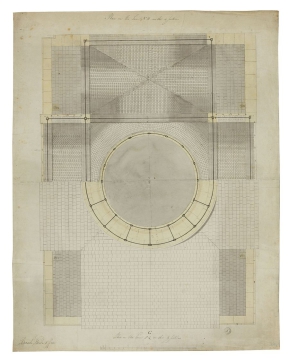
Browse
Reference number
Purpose
Aspect
Scale
Inscribed
Signed and dated
- datable to 1792-93
Medium and dimensions
Hand
Notes
At the top of the drawing, the plan runs through the crowning of the four projecting vaults, and shows the tie-rods bracing their outward thrusts by tying together the tops of the corner piers. This plan also shows tie-rods reinforcing the lip of the pendentive dome's oculus. At the bottom of the drawing the plan has been taken at a slightly higher line, at the base of the circular sill recessed back from the edge of the oculus and running beneath the lantern, where a ring of tie-rods girds the lantern bases' outer edge and is also bound to its inner edge helping the lip of the oculus to cantilever out over the crossing below.
The top half of the plan shows the construction of the vaulting with hollow-cone pots and the bottom half of the plan shows the slate roof above. This terra cotta pot construction can also be seen in the dome of the rotunda by J Nash at Buckingham Palace, by W Wilkins RA at the National Gallery and in the vault of the room added in 1837-9 by C R Cockerell to the University library at Cambridge (W Papworth [ed], The Dictionary of architecture, published in parts 1848-1892, volume VI, N-Q, p. 164). These bricks were hollow pots, square and closed at one end, but basically circular in section, with the other end domical and containing a small opening. It was the first time such construction had been employed in an English public building. However, it proved to be unsuccesful and resulted in leakage. See SM volume 74/21 and SM volume 74/37 for sections showing hollow-cone pot vaulting.
For an example of a hollow-cone pot see M. Richardson & M. Stevens (ed.), John Soane architect: master of space and light, Royal Academy of Arts, 1999, p. 237, cat. 145-146.
Level
Sir John Soane's collection includes some 30,000 architectural, design and topographical drawings which is a very important resource for scholars worldwide. His was the first architect’s collection to attempt to preserve the best in design for the architectural profession in the future, and it did so by assembling as exemplars surviving drawings by great Renaissance masters and by the leading architects in Britain in the 17th and 18th centuries and his near contemporaries such as Sir William Chambers, Robert Adam and George Dance the Younger. These drawings sit side by side with 9,000 drawings in Soane’s own hand or those of the pupils in his office, covering his early work as a student, his time in Italy and the drawings produced in the course of his architectural practice from 1780 until the 1830s.
Browse (via the vertical menu to the left) and search results for Drawings include a mixture of Concise catalogue records – drawn from an outline list of the collection – and fuller records where drawings have been catalogued in more detail (an ongoing process).

